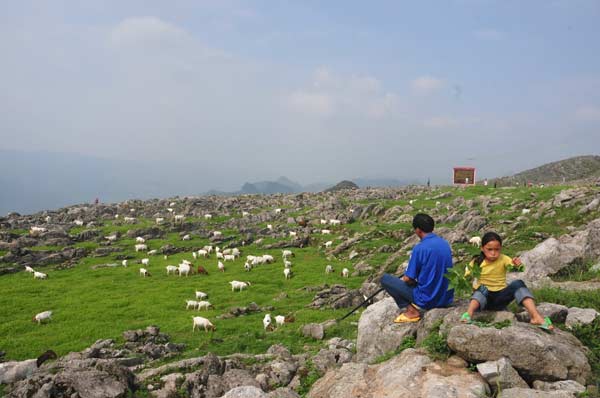Bleat of the hybrid ushers in new era
By Sun Yuanqing ( China Daily ) Updated: 2013-11-07 09:31:24
 |
|
[Photo/China Daily] |
Transfer technology is producing a type of sheep that flourishes in the harsh conditions of Qinglong county, Guizhou province, while lifting many local farmers out of poverty. Sun Yuanqing reports.
Fan Shunhua's day is a successful one when he hears the bleating of newborn lambs. Fan has experienced the happy sound more than 140 times this year and expects 60 more such occasions by year-end. With 400 Qinglong sheep in the sheepfolds, Fan rarely has a moment's rest. He goes out in the morning to collect grass, feeds the sheep several times a day and checks their health before going to bed.
| Seeds of hope |
| Going nuts |
"It is not easy to raise 400 sheep, but it's going very steadily. I actually regret not starting it earlier," Fan says.
Previously a mason with no stable income in Qinglong county in the southwestern province of Guizhou, Fan started raising sheep in 2011 along with many townsmen.
Qinglong sheep, a hybrid of local and foreign sheep, have become a way out for Qinglong county, a typical karst area plagued by rocky desertification and poverty.
"Australian White sheep are good in Australia, but not necessarily so in Qinglong. What we are doing right now is breeding a kind of sheep that can survive in Qinglong as well as the Australian White does in its own local environment," says Zhang Daquan, director of the Qinglong County Grassland Center, a government body that has been promoting animal husbandry on Qinglong's grassland.
What Zhang and his team have managed to breed is a kind of sheep that has the best of two worlds: the adaptability of the local livestock and the productivity of the world's best sheep for meat, including Australian White and Dorper sheep and Boer goats.
A local sheep gains about 35 kg a year, but a Qinglong hybrid can gain 50 kg in half a year. And the quality of meat is better. The local sheep feed only on browses, while the hybrid ones can eat almost anything grown on the ground.
"They are not only more adaptable than both the local and foreign breeds, but also more productive," Zhang says.
A local ewe gives birth to an average of one-and-a-half lambs a year, while the Qing-long hybrid sheep produces two sheep in the same period of time. Moreover, they are less likely to get diseases.
Instead of importing the foreign sheep that cost from 18,000 yuan ($2,960) to 25,000 yuan a head, which is unaffordable for the local farmers, the center applies a more economical and efficient method - embryo transfers.
The center cooperates with Australian and New Zealand breeding companies that provide embryos and transfer technology to implant the embryos in the wombs of the local sheep. Naturally a sheep produces about 15 lambs in a lifetime. With an embryo transfer, a sheep can produce more than 40 embryos that can be bred in the wombs of the surrogate sheep.
Peter Lynch, manager at Animal Breeding Services in New Zealand, says Qinglong is ready for embryo transfer technology given the current management level.
For more Eco China, here
|
|
|
|
|
|
|
|





























 Raymond Zhou:
Raymond Zhou: Pauline D Loh:
Pauline D Loh: Hot Pot
Hot Pot Eco China
Eco China China Dream
China Dream China Face
China Face






